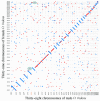Chromosome-Level Assembly of Male Opsariichthys bidens Genome Provides Insights into the Regulation of the GnRH Signaling Pathway and Genome Evolution
- PMID: 36290404
- PMCID: PMC9598921
- DOI: 10.3390/biology11101500
Chromosome-Level Assembly of Male Opsariichthys bidens Genome Provides Insights into the Regulation of the GnRH Signaling Pathway and Genome Evolution
Abstract
The hook snout carp Opsariichthys bidens is an important farmed fish in East Asia that shows sexual dimorphism in growth, with males growing faster and larger than females. To understand these complex traits and improve molecular breeding, chromosome-level genome assembly of male O. bidens was performed using Illumina, Nanopore, and Hi-C sequencing. The 992.9 Mb genome sequences with a contig N50 of 5.2 Mb were anchored to 38 chromosomes corresponding to male karyotypes. Of 30,922 functionally annotated genes, 97.5% of BUSCO genes were completely detected. Genome evolution analysis showed that the expanded and contracted gene families in the male O. bidens genome were enriched in 76 KEGG pathways, and 78 expanded genes were involved in the GnRH signaling pathway that regulates the synthesis and secretion of luteinizing hormone and glycoprotein hormones, further acting on male growth by inducing growth hormone. Compared to the released female O. bidens genome, the number of annotated genes in males was much higher (23,992). The male chromosome LG06 exhibited over 97% identity with the female GH14/GH38. Male-specific genes were identified for LG06, where structural variation, including deletions and insertions, occurred at a lower rate, suggesting a centric fusion of acrocentric chromosomes GH14 and GH38. The genome-synteny analysis uncovered significant inter-chromosome conservation between male O. bidens and grass carp, the former originating from ancestral chromosome breakage to increase the chromosome number. Our results provide a valuable genetic resource for studying the regulation of sexual dimorphism, sex-determining mechanisms, and molecular-guided breeding of O. bidens.
Keywords: Cyprinid fish; GnRH signaling; comparative genomics; hook snout carp; sexual dimorphism.
Conflict of interest statement
The authors declare no conflict of interest.
Figures








Similar articles
-
Genome-wide analysis reveals the contributors to fast molecular evolution of the Chinese hook snout carp (Opsariichthys bidens).Comput Struct Biotechnol J. 2024 May 31;23:2465-2477. doi: 10.1016/j.csbj.2024.05.048. eCollection 2024 Dec. Comput Struct Biotechnol J. 2024. PMID: 38882676 Free PMC article.
-
Chromosome-level genome assembly of a cyprinid fish Onychostoma macrolepis by integration of nanopore sequencing, Bionano and Hi-C technology.Mol Ecol Resour. 2020 Sep;20(5):1361-1371. doi: 10.1111/1755-0998.13190. Epub 2020 Jul 20. Mol Ecol Resour. 2020. PMID: 32419357
-
Chromosome-level genome assembly of grass carp (Ctenopharyngodon idella) provides insights into its genome evolution.BMC Genomics. 2022 Apr 7;23(1):271. doi: 10.1186/s12864-022-08503-x. BMC Genomics. 2022. PMID: 35392810 Free PMC article.
-
A Chromosome-Level Genome Assembly of the Dark Sleeper Odontobutis potamophila.Genome Biol Evol. 2021 Feb 3;13(2):evaa271. doi: 10.1093/gbe/evaa271. Genome Biol Evol. 2021. PMID: 33576781 Free PMC article.
-
The complete mitochondrial genome of the Chinese hook snout carp Opsariichthys bidens (Actinopterygii: Cypriniformes) and an alternative pattern of mitogenomic evolution in vertebrate.Gene. 2007 Sep 1;399(1):11-9. doi: 10.1016/j.gene.2007.04.019. Epub 2007 Apr 27. Gene. 2007. PMID: 17587513
Cited by
-
Genome-wide analysis reveals the contributors to fast molecular evolution of the Chinese hook snout carp (Opsariichthys bidens).Comput Struct Biotechnol J. 2024 May 31;23:2465-2477. doi: 10.1016/j.csbj.2024.05.048. eCollection 2024 Dec. Comput Struct Biotechnol J. 2024. PMID: 38882676 Free PMC article.
-
New perspectives on the genetic structure of dotted gizzard shad (Konosirus punctatus) based on RAD-seq.Mar Life Sci Technol. 2024 Feb 12;6(1):50-67. doi: 10.1007/s42995-024-00216-2. eCollection 2024 Feb. Mar Life Sci Technol. 2024. PMID: 38433959 Free PMC article.
-
Palmitic acid-modified GnRH-Th epitope peptide immunocastration vaccine (W/O/W adjuvant) can effectively ensure the castration and reduce the smelly smell in boars.Front Vet Sci. 2023 Apr 24;10:1174770. doi: 10.3389/fvets.2023.1174770. eCollection 2023. Front Vet Sci. 2023. PMID: 37168095 Free PMC article.
-
Three genome assemblies of Opsariichthys bidens from Yangzte River, Pearl River and Qiantang River basins.Sci Data. 2024 Oct 10;11(1):1110. doi: 10.1038/s41597-024-03899-5. Sci Data. 2024. PMID: 39389956 Free PMC article.
References
-
- Du G. Biological characteristics and artificial breeding technology of Opsariichthys bidens. North. Chin. Fish. 2021;40:50–52.
LinkOut - more resources
Full Text Sources
Research Materials
Miscellaneous

